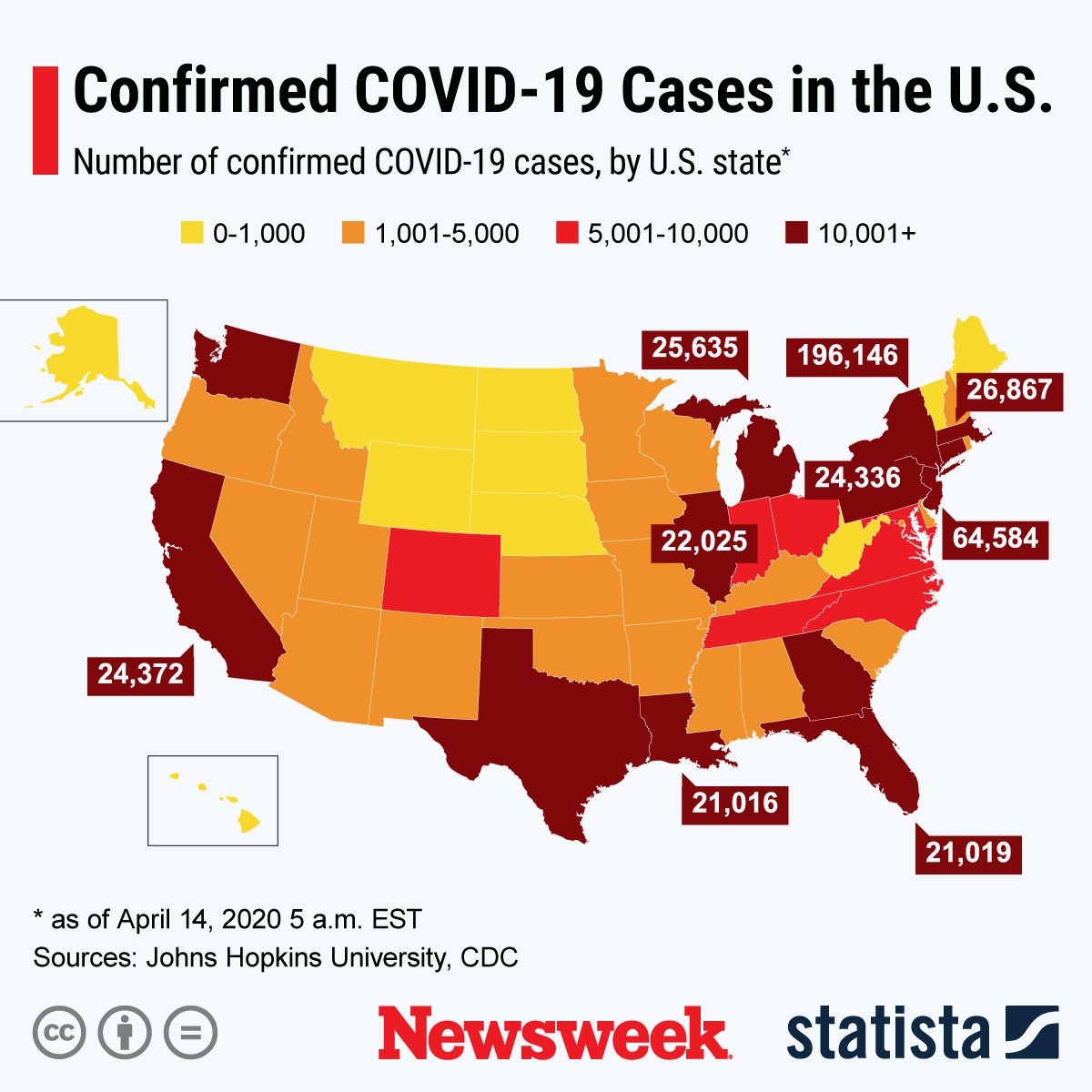The novel coronavirus has killed more than 25,000 in the U.S., with over 40 percent of the deaths reported to be in New York. The state has at least is 10,834 fatalities, as of Wednesday, according to the latest figures from Johns Hopkins University.
New York has the highest state death count in the country, followed by New Jersey (2,805 fatalities), Michigan (1,768), Louisiana (1,013) and Massachusetts (957).
New York continues to see hundreds die from the virus every day, including 778 on Monday, Governor Andrew Cuomo confirmed at a press conference on Tuesday.
Easter Sunday saw 671 new fatalities, which was "not as bad as it has been in the past," Cuomo noted on Monday.
Cuomo also confirmed that total hospitalizations in New York, after rising for a while, were "basically flat so we think we're at the apex on the plateau. The number of hospitalizations went up, flattened, continuing to flatten, good sign," he said Tuesday.
The three-day average of the net change in total hospitalizations and the net change in ICU (intensive care unit) admissions were also said to be down, Cuomo confirmed on Tuesday.
"We changed the curve...we are changing the curve every day. We have shown that we control the virus, the virus doesn't control us," he said.
"Just because those numbers are flattening, it's no time to relax. We're not out of the woods. In this reopening, we could lose all the progress we made in one week if we do it wrong. We have a number of challenges ahead. We have to figure out how to do this," he warned.

The death toll in the U.S. has been rising on a steep curve over roughly the past week, compared with that of Italy, Spain, France and the U.K., which has been starting to drop or flattening out, according to Financial Times' analysis of available data sources by reporter John Burn-Murdoch.
COVID-19, the illness caused by the novel coronavirus, is now the deadliest disease in the U.S., killing more people per day than cancer or heart disease. According to a graph published last week by Dr. Maria Danilychev from San Diego, COVID-19 is the cause of 1,970 deaths in the U.S. per day, while 1,774 deaths are attributed to heart disease and 1,641 to cancer.
Now subnational region daily deaths:
— John Burn-Murdoch (@jburnmurdoch) April 13, 2020
• Early signs that NY daily deaths may be peaking, but need to wait and see
• Same in London, though Easter weekend reporting is having a big downward effect on UK numbers
All charts: https://t.co/JxVd2cG7KI pic.twitter.com/vgHzYY55aE
Last week, Assistant Secretary for Health Brett Giroir warned: "[This is] going to be the peak hospitalization, peak ICU week and unfortunately, peak death week."
He added that this does not mean the outbreak will start to come to an end, with other parts of the country expected to face their peaks at a later date. "We have to be very, very serious about what's happening this week, the next week, the following weeks," Giroir said.
The COVID-19 virus, which was first reported in Wuhan, China, has spread to more than 1.9 million people across at least 185 countries and regions. Over 126,700 people have died, while nearly 493,000 have recovered from infection. The U.S. is the epicenter of the outbreak, with more than 609,000 confirmed cases, as of Wednesday.
Top 10 states with most COVID-19 deaths
(as of April 15)
- New York—at least 10,834 deaths
- New Jersey—at least 2,805 deaths
- Michigan—at least 1,768 deaths
- Louisiana—at least 1,013 deaths
- Massachusetts—at least 957 deaths
- Illinois—at least 868 deaths
- California—at least 788 deaths
- Pennsylvania—at least 696 deaths
- Florida—at least 571 deaths
- Washington—at least 541 deaths
The graphic below, provided by Statista, illustrates the spread of COVID-19 across the U.S.

Data on COVID-19 cases is from Johns Hopkins University unless otherwise stated.
Centers for Disease Control and Prevention Advice on Using Face Coverings to Slow Spread of COVID-19
- CDC recommends wearing a cloth face covering in public where social distancing measures are difficult to maintain.
- A simple cloth face covering can help slow the spread of the virus by those infected and by those who do not exhibit symptoms.
- Cloth face coverings can be fashioned from household items. Guides are offered by the CDC. (https://www.cdc.gov/coronavirus/2019-ncov/prevent-getting-sick/diy-cloth-face-coverings.html)
- Cloth face coverings should be washed regularly. A washing machine will suffice.
- Practice safe removal of face coverings by not touching eyes, nose, and mouth, and wash hands immediately after removing the covering.
World Health Organization advice for avoiding spread of coronavirus disease (COVID-19)
Hygiene advice
- Clean hands frequently with soap and water, or alcohol-based hand rub.
- Wash hands after coughing or sneezing; when caring for the sick; before, during and after food preparation; before eating; after using the toilet; when hands are visibly dirty; and after handling animals or waste.
- Maintain at least 1 meter (3 feet) distance from anyone who is coughing or sneezing.
- Avoid touching your hands, nose and mouth. Do not spit in public.
- Cover your mouth and nose with a tissue or bent elbow when coughing or sneezing. Discard the tissue immediately and clean your hands.
Medical advice
- Avoid close contact with others if you have any symptoms.
- Stay at home if you feel unwell, even with mild symptoms such as headache and runny nose, to avoid potential spread of the disease to medical facilities and other people.
- If you develop serious symptoms (fever, cough, difficulty breathing) seek medical care early and contact local health authorities in advance.
- Note any recent contact with others and travel details to provide to authorities who can trace and prevent spread of the disease.
- Stay up to date on COVID-19 developments issued by health authorities and follow their guidance.
Mask and glove usage
- Healthy individuals only need to wear a mask if taking care of a sick person.
- Wear a mask if you are coughing or sneezing.
- Masks are effective when used in combination with frequent hand cleaning.
- Do not touch the mask while wearing it. Clean hands if you touch the mask.
- Learn how to properly put on, remove and dispose of masks. Clean hands after disposing of the mask.
- Do not reuse single-use masks.
- Regularly washing bare hands is more effective against catching COVID-19 than wearing rubber gloves.
- The COVID-19 virus can still be picked up on rubber gloves and transmitted by touching your face.
Uncommon Knowledge
Newsweek is committed to challenging conventional wisdom and finding connections in the search for common ground.
Newsweek is committed to challenging conventional wisdom and finding connections in the search for common ground.
About the writer
Soo Kim is a Newsweek reporter based in London, U.K. She covers various lifestyle stories, specializing in travel and health.
Soo ... Read more
To read how Newsweek uses AI as a newsroom tool, Click here.








